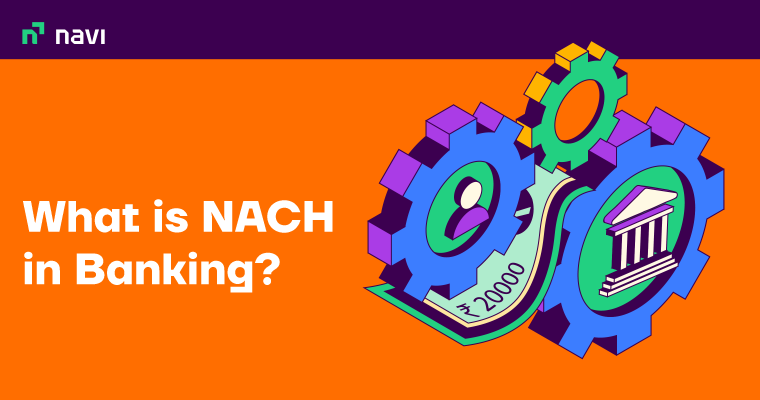NACH in Banking (National Automated Clearing House)

National Automated Clearing House (NACH) is a platform created by the National Payments Corporation of India (NPCI) to facilitate fund clearing. NACH Credit and NACH Debit provide interbank high volume, high or low-value credit/debit bulk transactions that are recurring/repetitive through the electronic NPCI service. For example, if you make a purchase and every month an EMI amount gets auto-debited from your bank account.
Read on to know about NACH in banking, how it works, its features and benefits and how to set up a NACH mandate.
Objectives of NACH in Banking
NACH’s full form in banking is National Automated Clearing House. It aims to facilitate high-volume transactions. The main objectives of NACH are:
- It supports mobile-based and Aadhaar-based Automated Clearing House transactions.
- The regulations to be followed by the users are easy to comprehend and follow.
- NACH operates as a centralised system for multiple ECS systems.
- This technology is capable of managing large numbers of repetitive payments.
How does NACH in Banking Work?
NACH was launched by NPCI for simpler and faster processing of automated bulk transactions. Here’s a step-wise guide on how it works:
- Companies provide NACH mandate forms to consumers to get their consent for debiting their account at a certain frequency for a certain period of time.
- The Company will verify all details provided by consumers in their NACH mandate form.
- Upon successful verification, the company will forward the form to its respective bank.
- The bank will send the mandate form to NPCI.
- Once the details are fully validated, NPCI will forward the mandate form to the customer’s bank.
- Upon approval of the customer’s bank, the company is permitted to debit funds from the customer’s account.
Features and Benefits of NACH in Banking
Here are the features and benefits of NACH in banking:
For Customers
- The procedure is secure and safe.
- You can validate your transfer request through NACH with net banking credentials.
- It is a user-friendly facility with prompt cancellation and easy access.
- You need not remember the recurring payment dates as the funds are automatically debited.
- It saves time since the transactions are settled within a day.
- The automated procedure manages the recurring payments smoothly.
For Banks
- There is no possibility of late payments.
- Chances of theft and fraud are significantly minimised.
- The online transactions ensure effective management.
- There’s no cost of invoicing.
- Since the service doesn’t require cheque clearing, it is less complex.
- Due to swift payment approvals, the banks can improve customer relationships.
For Organisations
- Easy bill settlements bring forth higher consumer satisfaction.
- It is time-saving for an organisation since a large number of beneficiaries receive money quickly owing to minimal approval time.
- This online mandate doesn’t involve clearing huge volumes of cheques.
Also Read
Types of NACH in Banking
NACH banking consists of two variants – NACH Credit and NACH Debit. Let’s understand them!
1. NACH Credit
NACH Credit refers to an electronic payment facility that an institution uses to provide credits to a huge pool of beneficiaries in their registered bank accounts for paying pension, salary, interest, dividends, and more. It raises only a single debit to the user institution’s bank account (corporate enrollment for the NACH facility).
2. NACH Debit
NACH Debit enables a corporation to collect insurance premiums, investments in mutual funds, EMI payments, tax/cess, water/electricity/telephone bills. A user institution receives these repetitive or periodic payments from a large pool of consumers.
How to Set Up NACH Mandate?
If you want to start a NACH mandate, follow these steps:
- Step 1: Visit your bank’s website and fill up the NACH mandate form.
- Step 2: You will get redirected to the destination bank’s website. Validate your request using your net banking credentials.
- Step 3: The bank will verify your details and make a decision on whether to reject or accept your request.
- Step 4: Upon approval, you can schedule your future transactions.
- Step 5: You will receive a numeric code known as UMRN for later reference.
NACH Form
NACH is a centralised digital payment system launched by NPCI to make the process of bulk payments of companies faster and simpler for destination banks. Repetitive payments such as EMIs, cash loans, subscriptions, etc., can now also be made using NACH.
Customers should fill up and submit NACH forms to authorise their banks to debit funds at a specified interval. After it goes through a multi-layer verification by the customer’s bank, NPCI and the destination bank, the auto-deduction process is initiated.
List of Banks Providing NACH Services
Here’s a list of a few major banks which provide NACH services:
- State Bank of India
- ICICI Bank
- HDFC Bank
- Citi Bank
- Axis Bank
Charges Associated with NACH
NPCI manages and monitors NACH and its operations. It levies certain charges from banks and financial institutions for NACH services. The following are some of the standard charges levied by NPCI:
1. Incentive and Processing Fee for Credit Transactions (Direct Benefit Transfer)
For Aadhaar-based credit transactions and ACH- Rs.0.15 & Rs.0.40 for on-us & off-us transactions, respectively.
2. Processing Fee for Credit Transactions other than Direct Benefit Transfer
For account-based ACH credit- Rs.0.05 and Rs.0.45 for On-us and Off-us transactions, respectively.
3. Processing Fee and Penalty Payment on Debit Transactions:
For NACH and ACH debit- Rs.0.05 & Rs.0.70 for On-us and Off-us transactions, respectively.
4. Penalty Payment for Repetitive Errors:
- Rs.25 per error from the third instance of issues such as “account closed” or “no such account” as NACH 306 charges.
- Rs.25 per error for the third time for the “account closed” issue as NACH debit (ECS).
5. Processing Charge, Penalty and Incentive on a Mandate:
- Rs.1.00 for the and Rs.5 as processing charge and incentive for the sponsor bank, respectively.
- Rs.0.50 and Rs.10 as processing charges and penalties for the destination bank, respectively.
6. Processing Fee and Incentive for e-Mandate:
- Processing fee and incentive of Rs.0.50 and Rs.5, respectively, for the sponsor bank.
- Processing fee and penalty of Rs.0.50 and Rs.10, respectively, for the destination bank.
How to Cancel the NACH Mandate?
The process of NACH cancellation is a simple one. Here are the steps:
- Step 1: Visit the website of your bank or financial institution.
- Step 2: Log in to the net banking facility with your credentials.
- Step 3: Go to the ‘Service Request’ page.
- Step 4: In the ‘Account Related’ section, you will find the option for NACH service cancellation.
You can also cancel the NACH mandate through mobile banking. Or, visit the nearest branch of a bank or financial institution and submit a duly filled cancellation form to do the same task.
How to Check the NACH Mandate Status?
To check the NACH mandate status, you need to follow the given steps:
- Step 1: Visit the website of the bank or financial institution.
- Step 2: Log in to net banking using your credentials.
- Step 3: You will find your NACH status under the ‘Service Request’ tab.
What is e-Mandate and e-NACH?
Mandate means a set of instructions provided to a bank by a customer, which allows the bank to debit a certain amount at a specific interval. NACH helps banks, financial institutions and government bodies provide automated payment services.
e-NACH and e-mandate both perform the same duties as far as the end result is concerned but are implemented differently. Both are digital payment services launched by a joint venture of RBI and NPCI to make bulk payments smoother and faster which are repetitive in nature.
APB System in NACH
APB or Aadhaar Payment Bridge System for NACH was introduced by NPCI to help the government make its Direct Benefit Transfer schemes successful. It involves using the Aadhaar number to verify beneficiaries of government schemes.
It has managed to constructively channel the government subsidies and benefits to its appropriate beneficiaries. On one hand, the ABP system links the government banks and their sponsor departments. On the other hand, it connects beneficiaries with beneficiary banks.
What is UMRN and What is Its Importance?
UMRN stands for Unique Mandate Reference Number which is automatically generated by NACH when creating a mandate. It is a unique numeric code that you can use for future reference. It can be used for tracking mandate details and for mandate cancellation and amendment.
The only difference between e-Mandate and e-NACH is that e-NACH is managed by NPCI and covers 40+ banks while e-Mandate is governed by individual banks.
Differences Between NACH and ECS
RBI has introduced the Electronic Clearing Service (ECS) mandate to facilitate periodic payments. It enables electronic debit and credit transactions at regular intervals from your account. Though you may think that it is similar to the NACH mandate, there are some significant differences between them.
| ECS | NACH |
| ECS is a manual procedure and takes time for transaction settlement. | NACH is a web-based and automated procedure. |
| It has no committed dispute management system. | It has a committed dispute management system. |
| Payment settlement may take up to four days. | Payment settlement takes place within a day. |
| The registration procedure may take between 25 and 30 days. | Registration confirmation comes by the end of the day. |
| It has a high probability of rejection and involves lengthy paperwork. | It involves a convenient application procedure and minimum paperwork. |
| This process doesn’t give a reference number. | You will receive a UMRN (Unique Mandate Reference Number) for future references. |
Final Word
NACH in banking offers timely payment of funds for the consumers and user institutions. Besides, it is less dependent on paper transactions, cheques and manual intervention. All organisations authorised under the RBI criteria can choose to utilise NACH Credit for sending substantial amounts to multiple recipients.
FAQs
A corporate will have to register with NPCI to opt for NACH services. It will obtain a Utility Code (Unique Identification Code) for NACH facilities via the sponsor bank. A sponsor bank is a bank that initiates or lodges the transaction files for the distribution and collection of funds on behalf of a registered corporation.
A one-time registration procedure is known as a mandate. It is the permission given to your bank for debiting your account up to a fixed limit or with a specific amount. It is in accordance with the frequency you provided in the mandate form.
UMRN (Unique Mandate Reference Number) is allocated to every new mandate under NACH Debit. The system automatically generates it during the creation of the mandate. UMRN is required for all transactions, even at the time of mandate cancellation and amendment.
NACH transactions involve specific mandate charges. A destination bank, as well as a sponsor bank, will have to pay processing fees for e-mandates (online procedure). Further, a penalty charge is applicable for a destination bank in case the mandate is not processed within 10 business days.
If you are registered with NACH, you can alter your details after filling in the mandate form and choosing the ‘Modify’ option. Similarly, you can cancel your NACH registration by filling in the same form and selecting the ‘Cancel’ option.
Disclaimer
This article is solely for educational purposes. Navi doesn't take any responsibility for the information or claims made in the blog.

10 Best Bank for Savings Account in India [Highest Interest Rate 2023]
Savings account is a type of financial instrument offered by several banks. It lets you safely depo... Read More »What is Issuer Identification Number (IIN)- Working and Importance
What is an Issuer Identification Number (IIN)? Banks and financial institutions assign a distinc... Read More »What is a Vostro Account – Meaning, Working and Difference
What is a Vostro Account? A Vostro account is a bank account held by a domestic bank on behalf o... Read More »What is a Solvency Certificate? – Format, Documents Required & How to Apply Online?
What is a Solvency Certificate? A solvency certificate is a legal document furnishing the detail... Read More »What is Merchant Banking – Services, Features, Functions and Example
What is Merchant Banking? Merchant banking is a set of select banking and financial services off... Read More »Automated Clearing House: Objectives, Types and Process
Automated Clearing House is an electronic fund transfer network that manages automatic and direct... Read More »How to Redeem Credit Card Reward Points ?
Credit Card Reward points are types of incentives that customers receive when they use a credit car... Read More »What is Electronic Clearing Service (ECS) in Banking and How does it Work?
What is Electronic Clearing Service (ECS)? Electronic Clearing Service (ECS) is a method of elec... Read More »What are Credit Card Validators and How to Use them?
What is a Credit Card Validator? A credit card validator is a tool that checks the validity of a... Read More »What is Cash Management and How Does it Work?
Managing available capital can make sure that a small business stays afloat. Cash management is an ... Read More »What are Prepaid Expenses? – Definition, Examples, and Journal Entry
Prepaid expenses represent payments made in advance for products or services expected to be incurre... Read More »Increase Credit Card Limit – Important Tips and How to Do It?
The credit card limit is the maximum amount of money you can spend using your credit card. Your cre... Read More »Top 10 Chit Fund Schemes in India in 2023
Chit funds are one of the most popular return-generating saving schemes in India. It is a financial... Read More »10 Best Gold ETFs in India to Invest in April 2023
Gold ETFs or Gold Exchange Traded Funds are passively managed funds that track the price of physica... Read More »10 Best Demat Accounts in India for Beginners in 2023
Creation of Demat accounts revolutionised the way trades were conducted at the stock exchanges. It... Read More »20 Best Index Funds to Invest in India in April 2023
What is an Index Fund? An index fund is a type of mutual fund or exchange-traded fund (ETF) that... Read More »Best Arbitrage Mutual Funds to Invest in India in April 2023
Arbitrage funds are hybrid mutual fund schemes that aim to make low-risk profits by buying and sell... Read More »10 Best SIP Plans in India to Invest in April 2023
What is SIP? SIP or Systematic Investment Plan is a method of investing a fixed amount in ... Read More »10 Best Corporate Bond Funds in India to Invest in April 2023
Corporate bond funds are debt funds that invest at least 80% of the investment corpus in companies ... Read More »10 Best Bank for Savings Account in India [Highest Interest Rate 2023]
Savings account is a type of financial instrument offered by several banks. It lets you safely depo... Read More »































